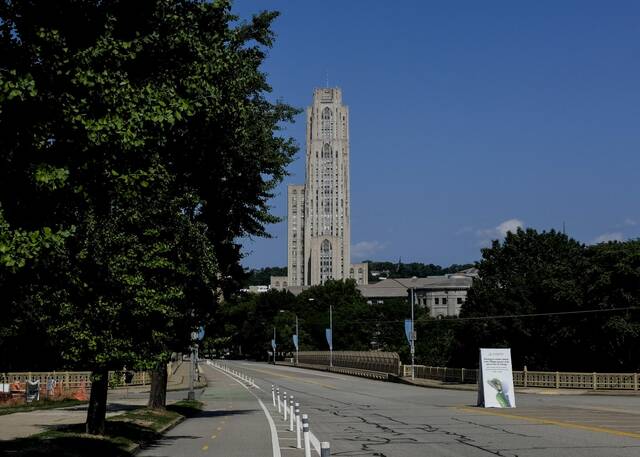https://triblive.com/local/oakland-plan-aims-to-bolster-jobs-affordable-housing-green-space-other-community-needs/
Oakland Plan aims to bolster jobs, affordable housing, green space, other community needs

The Oakland Plan, a neighborhood project that has been in the works for more than two years, aims to address a variety of community needs, including housing, job opportunities, green space and improved mobility systems.
Pittsburgh’s Planning Commission has been briefed on the plan over the course of their two most recent meetings. They will ultimately vote on whether or not to adopt the plan, though related zoning changes will need City Council approval.
The Oakland Plan, which was unveiled last month, contains goals for the Oakland neighborhood’s future. It’s focused on four major themes, said Stephanie Joy Everett, who worked on the plan with the city’s Department of City Planning.
They include growing housing and job opportunities in Oakland; using public and private investments to increase livability through new open spaces, community services and amenities; reimagining mobility systems to prioritize ease and safety for pedestrians, transit riders and bicyclists; and addressing inequities for Black residents, students and immigrants living in the neighborhood.
Residents participating in the process called for turning Oakland into a “twenty-minute neighborhood,” where residents can meet all of their basic needs within a 20-minute walk from their home, said Josiah Gilliam, representing the city’s Office of Equity.
The plan suggests creating community service hubs, where people who live and work in the neighborhood would have access to amenities ranging from wi-fi and daycare to career services and educational programming, Gilliam said.
Other priorities for making Oakland a more livable neighborhood include improving public safety, increasing food access, combating institutional racism and designing places for the neighborhood’s children to thrive, he said.
The plan also calls for increased green spaces, including 15-foot green buffer areas for some new developments.
Another key element of the plan is improving mobility systems, particularly for pedestrians and cyclists.
Thomas Scharff, who worked on the plan in Pittsburgh’s Department of City Planning, said the proposal aims to ensure Oakland residents can access a local transit stop within a five-minute walk. It also suggests improving amenities at well-used transit stops by implementing seating, lighting, public art and green features, and ensuring they are ADA-compliant.
The plan proposes making the neighborhood more bike-friendly by reducing the number of vehicle lanes on a portion of Boulevard of the Allies from Bates into Schenley Park to allow for a two-way bike lane.
“The idea of biking on Boulevard of the Allies, I got very excited,” Commissioner Becky Mingo said.
Mingo said she liked the idea of making Oakland a “safer and gentler place,” particularly for pedestrians and cyclists.
The Oakland Plan also emphasizes affordable housing and job opportunities.
“We can’t just focus on affordable housing. We also have to focus on jobs and who has access to jobs in the neighborhood,” said Derek Dauphin, who formerly served as the project manager for the Oakland Plan.
The plan calls for jobs and housing for all, with specific emphasis on providing housing for front line and low-income workers and ensuring Black residents’ needs are addressed through “initiatives that create housing and fight displacement,” Dauphin said.
It also suggests working to provide the right mix of housing and proper amenities to attract the many students studying in Oakland to stay in the neighborhood as permanent residents after graduating.
“Inclusionary zoning” pushed
To ensure affordable housing goals are met, the neighborhood plan calls for mandatory inclusionary zoning in Oakland, which would require developers to earmark a percentage of housing units as affordable housing to people making up to 50% of the area median income for renters or 80% of the area median income for homeowners for at least 35 years, said Kate Rakus, a planner with the Department of City Planning.
This requirement would not be included in the portion of Oakland zoned for educational and medical institutions, she said, as most housing there is dormitory housing for students.
Other portions of the neighborhood would be zoned as:
• Urban Center — Employment, where zoning would allow for a wide range of commercial uses and multi-unit residential housing only if all units are affordable or if residential use makes up no more than half of the property’s gross square footage;
• Urban Center — Mixed Use, where there would be a wide range of commercial uses, plus residential uses;
• Residential — Mixed Use, where zoning would allow residential uses, plus some smaller scale commercial uses meant to serve residents.
The full plan is available on the city’s website, where residents can also provide public comment on the proposal until May 1.
The plan will appear before the Planning Commission again on May 17. The commissioners are expected to vote on the plan at that time.
They also will vote on whether to recommend zoning changes in the neighborhood, though that would additionally require approval from City Council.
Copyright ©2026— Trib Total Media, LLC (TribLIVE.com)
